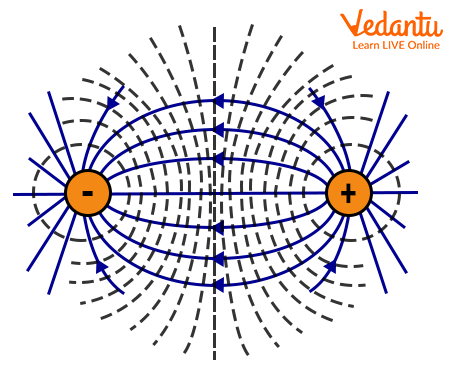




What Are the Key Properties of Electric Field Lines?
The concept of electric field lines provides a simplified method for visualising the presence, direction, and properties of electric fields around charges. These lines represent the direction and strength of the electric field and are governed by specific rules that support problem solving in electrostatics at the JEE level.
Definition and Representation of Electric Field Lines
Electric field lines are imaginary lines that indicate the direction in which a positive test charge would move under the action of the electric field. They originate from positive charges and terminate at negative charges.
The density of these lines reflects the relative magnitude of the electric field: closer spacing implies a stronger field, while wider spacing indicates a weaker field. A tangent at any point on an electric field line shows the exact direction of the electric field at that point.
The SI unit of electric field is Newton per Coulomb (N/C), or equivalently volt per metre (V/m). The symbol used for electric field is $E$. For related foundational concepts, refer to Electric Field Lines.
Visualisation of Electric Field Lines
The arrangement of field lines depends on the nature and distribution of electric charges. For a single positive charge, the field lines radiate outward uniformly. For a single negative charge, the lines converge inward.

When two opposite charges are placed close together, field lines emerge from the positive charge and terminate at the negative charge, depicting the direction of force on a positive test charge. In contrast, for like charges, the lines show repulsion by diverting away from each other. These patterns are crucial to understanding interaction between charges and can be further explored in Electric Field Due To Infinite Plane.

Properties of Electric Field Lines
Electric field lines have distinct properties that help in analysing electric fields in various configurations. These properties are essential for solving problems related to electrostatics.
- Electric field lines originate from positive charges and terminate at negative charges
- The direction of a field line at any point gives the direction of the electric field vector at that point
- No two electric field lines ever intersect each other
- The number of lines drawn is proportional to the magnitude of the charge
- Field lines are denser where the field is stronger
- Field lines are perpendicular to the surface of a conductor
- Electric field inside a conductor is always zero under electrostatic conditions
- Lines never form closed loops for an isolated charge
- In a uniform field, the lines are parallel, equally spaced, and straight
- Field lines contract longitudinally between unlike charges due to attraction and expand laterally between like charges due to repulsion
Implications of Field Line Properties
The non-intersection property of electric field lines ensures that at any point in space, the direction of the electric field is unique. If two lines were to intersect, a test charge placed at that point would experience two directions of force, which is physically impossible.
The normal emergence of field lines from a charged surface indicates that the electric field near a conductor's surface is perpendicular to it. Inside conductors, in electrostatic equilibrium, the field becomes zero, and hence field lines do not penetrate the conductor.
The relationship between the number of field lines ($n$) and the charge ($q$) can be expressed as:
$n \propto q$
This proportionality helps in visual identification and comparison of charge magnitudes in field diagrams. For advanced applications and analysis, see Electric Flux Through Cone Or Disc.
Uniform and Non-Uniform Electric Fields
A uniform electric field is one in which the electric field strength is constant in both magnitude and direction at every point. This occurs, for example, between two large parallel conducting plates with a constant potential difference.
In a uniform field, electric field lines are parallel, equally spaced, and straight. In a non-uniform field, both the magnitude and direction of the field vary from point to point, leading to non-parallel and unevenly spaced field lines. Related concepts can be reviewed in Electric Field Due To Linear Charge.
| Type of Field | Field Line Pattern |
|---|---|
| Uniform | Parallel, equally spaced, straight |
| Non-uniform | Non-parallel, varying spacing |
Common Applications and Examples
Electric field lines are used to analyse the configuration of charges, the interaction between charges, and the effect of conductors and dielectrics. Patterns can explain attractive or repulsive forces and potential zero-field points between charges of unequal magnitude.
In the case of a single point charge, the field lines radiate symmetrically outward or inward depending on the sign of the charge. For two or more charges, the superposition principle helps in drawing the resultant field lines. For a comprehensive treatment of foundational electrostatics, see the Electrostatics Overview.
Key Points on Electric Field Lines
- Lines represent the direction of force on a positive test charge
- No two field lines can cross
- Field strength is shown by the density of lines
- Field lines begin at positive charges and end at negative charges
- Equally spaced, parallel lines represent a uniform field
- Field lines are always perpendicular at conducting surfaces
FAQs on Understanding Electric Field Lines and Their Main Properties
1. What are electric field lines?
Electric field lines are imaginary lines that represent the direction and strength of the electric field at various points in space around a charge. They show how a positive test charge would move under the influence of the field.
- They originate from positive charges and end at negative charges.
- These lines never intersect each other.
- The density of field lines indicates the strength of the electric field – closer lines mean a stronger field.
- They provide a visual representation of electric field direction and magnitude.
2. State the main properties of electric field lines.
Electric field lines follow certain distinct properties that help in understanding the behaviour of electric fields:
- They start from positive charge and end at negative charge (or at infinity in the absence of opposite charge).
- The direction of the tangent at any point on a field line gives the field direction at that point.
- Field lines never intersect because a point can't have two different field directions.
- The closer the lines, the stronger the field intensity.
- Electric field lines are always perpendicular to the surface of a conductor.
3. What does it mean if electric field lines are close together?
If electric field lines are close together, it means the electric field is strong in that region.
- Higher line density = stronger field strength
- Lower line density = weaker electric field
4. Why can electric field lines never intersect each other?
Electric field lines never intersect because at any given point, the electric field can only have one direction.
- If lines crossed, one point would have two directions for the field, which is not possible.
- This property ensures the uniqueness of field direction at every point.
5. How are electric field lines drawn for a single point charge?
For a single point charge, electric field lines radiate symmetrically in all directions.
- From positive charge: lines go outward
- Toward negative charge: lines come inward
- The pattern is radial and symmetric around the charge
6. What is the significance of tangent at a point on electric field lines?
The tangent to electric field lines at any point indicates the exact direction of the electric field at that location.
- Shows path of a positive test charge
- Useful in determining the field vector's direction
7. List three differences between electric field lines and magnetic field lines.
Electric field lines and magnetic field lines differ in several ways:
- Electric field lines start on positive charges and end on negative charges, while magnetic field lines form closed loops.
- Electric field lines never cross each other; magnetic field lines also do not intersect but always form closed paths.
- Electric field lines originate or terminate at charges; magnetic field lines have no actual start or end.
8. Why do electric field lines not form closed loops?
Electric field lines do not form closed loops because they always start on positive and end on negative charges (or infinity), representing the unidirectional nature of the electric field.
- This reflects the presence of monopole charges (unlike magnetic monopoles, which do not exist).
- Closed loops would imply a field returning to its source, which does not happen for electric fields.
9. Describe the behaviour of electric field lines near a conductor.
Near a conductor, electric field lines are always perpendicular to the surface.
- This orientation minimizes potential and ensures equilibrium.
- No electric field exists inside a charged conductor in electrostatic equilibrium.
10. What happens to electric field lines between two like charges placed close to each other?
When two like charges are close together, their electric field lines diverge and repel each other.
- Lines never cross, creating a region between them where the field is weak.
- This shows the repulsive nature of like charges.
11. What happens to the number of field lines per unit area as field intensity increases?
As field intensity increases, the number of electric field lines per unit area increases.
- Represents stronger electric field strength
- Helps visualize areas of high and low field intensities
12. Can electric field lines pass through insulators and conductors?
Electric field lines can pass through insulators but are perpendicular and do not exist inside conductors in electrostatic equilibrium.
- Inside conductors: field is zero; lines stop at the surface.
- Through insulators (dielectrics): field lines can pass and may bend depending on the material's properties.
























